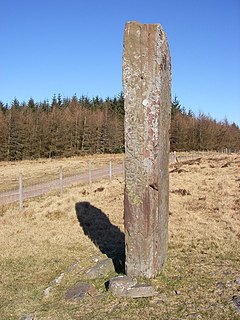Related Research Articles

The Maen Madoc or Maen Madog stone is a menhir which lies adjacent to the Roman road Sarn Helen that runs across the Brecon Beacons in what was a key area of Roman Wales, about one mile (2 km) north of Ystradfellte. It stands approximately 10 feet high.

Hen Domen Welsh, meaning "old mound", is the site of a medieval timber motte-and-bailey castle in Powys, Wales. It is the site of the original Montgomery Castle, and was built by Roger de Montgomery in 1070. From 1105 the castle was the home of the de Boulers (Bowdler) family, and it is from Baldwin de Boulers that Montgomery gets its Welsh name, Trefaldwyn "The Town of Baldwin". When the castle was rebuilt in stone (1223–1234), it was decided to rebuild it on a rocky promontory a mile to the south-east – the location of the current town of Montgomery, Powys. The Hen Domen site has been extensively excavated.

Moel y Gaer, also known as Moel-y-Gaer Camp or Moel y Gaer Hillfort, is an Iron Age hillfort located on a western spur of the Clwydian Range, near the village of Llanbedr, Denbighshire, Wales. The site is a scheduled monument, classified as a prehistoric defensive hillfort.

Moel y Gaer is an Iron Age hillfort on a summit of Llantysilio Mountain, northwest of the town of Llangollen, Denbighshire, Wales. The site is a scheduled monument classified as a prehistoric defensive hillfort.

Burfa Castle is an Iron Age hillfort near the tiny town of Old Radnor, Radnorshire in Powys, Wales. The site is a scheduled monument described as a prehistoric defensive hillfort, and was included in an inventory of monuments by 1913. The site is near Offa's Dyke which passes near the bottom of Burfa Bank.

Ffynnon Beuno and Cae Gwyn Caves are two Scheduled Ancient Monuments, in Denbighshire, Wales, which are also designated a Site of Special Scientific Interest (SSSI).

Cefn Meiriadog is a rural community in Denbighshire, Wales, just south-west of the city of St Asaph. The boundary of the community on three sides is the river Elwy, which here forms the county boundary with Conwy County Borough. Arguably the largest settlement in the community is the hamlet of Bontnewydd. Also in the community are the hamlets of Groesffordd Marli where Ysgol Cefn Meiriadog is situated, and Cefn.

Maen Huail is a stone block at St Peter's Square, in the centre of Ruthin, Denbighshire, North Wales. A circular plaque next to it states "Maen Huail on which tradition states, King Arthur beheaded Huail, brother of Gildas the historian". The stone was recorded in 1699 as being in the middle of the road, and now stands on a concrete plinth against the half-timbered wall of the Barclays Bank building, a 20th-century copy of the now mainly destroyed Exmewe Hall.

Llangar Church, or All Saints Old Parish Church, Llangar, was formerly the parish church of Llangar with Cynwyd, in the Dee Valley, Denbighshire, North Wales. It is now under the guardianship of Cadw, is a Scheduled Monument, and a grade I Listed Building. It is conserved and open to the public as an example of a rural church with medieval wall paintings and largely intact 18th century interior fittings.

Bedd-y-Cawr Hillfort, or Bedd y Cawr Hillfort, is an Iron Age hillfort on a natural inland promontory in the community of Cefnmeiriadog in Denbighshire in North Wales. The name of the hillfort translates from the Welsh as Giant's Tomb.
References
- ↑ Cefn Caves (ID PRN19306) . in the ' SMR ' for Clwyd Powys Archaeological Trust (CPAT). (Cadw SAM reference ID: DE115: Cefn Cave)
- ↑ Cefn Rocks, Caves (ID NPRN94801) . at the Royal Commission on the Ancient and Historical Monuments of Wales (RCAHMW).
- ↑ Cefn Old Cave (ID PRN102136) . in the ' SMR ' for Clwyd Powys Archaeological Trust (CPAT)